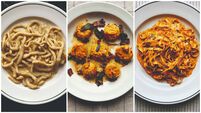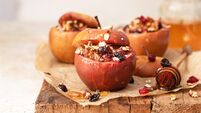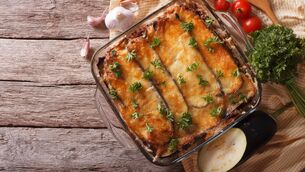Darina Allen: A pair of steak recipes for the connoisseur
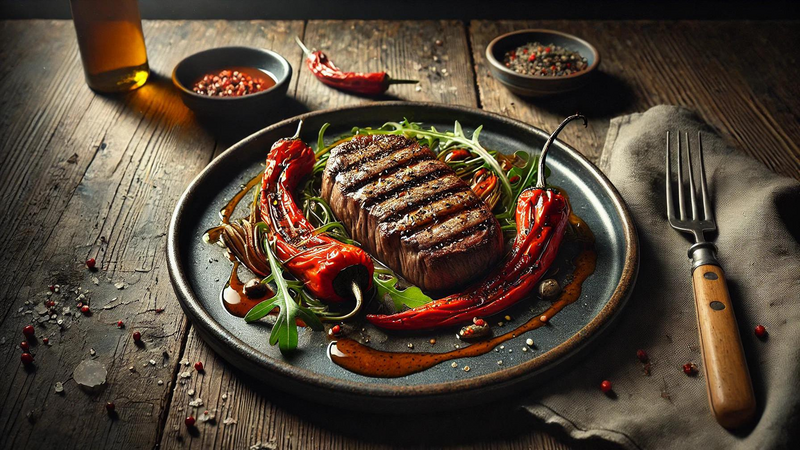
Pan-grilled Steak with Roasted Peppers & Anchoïade
The Curragh in Co Kildare is usually associated with the Irish army barracks, or a fine day's horse racing at the Irish Derby, Oaks, Irish Guineas, St. Ledge… but recently, butchers from all over the country, north and south, converged on the Curragh, clutching boxes of precious homemade sausages, black puddings and their finest steaks.
They were there to compete in the National Irish Steak Challenge, and I was invited to be a judge along with 30 others including master butchers, meat scientists, industry professionals and chefs.
What a day! We tasted and judged over 25 sirloin, rump, and fillet steaks. Other teams of judges tasted the sausages and the black and white puddings.
Chefs Dolan Heaney, Sean Owens and their teams laboured non-stop all day cooking the steaks in the kitchen of the Curragh restaurant, normally frequented by hungry racegoers.
The awards are a serious business: we worked in threes, examining first the raw steaks, then tasting mostly juicy morsels of the cooked meat.
We each marked them for appearance, flavour and tenderness, then we tasted.
Finally it was narrowed down to six finalists to ascertain the winners. We tasted and pondered over 100 steaks in total.
Here in Ireland, despite the fact that we’ve lost quite a number of butchers, we are fortunate to still have many local butchers.
This is not the case in many countries where the meat business has been lost to the big meat plants and supermarkets.
Animals are slaughtered and butchered in large meat factories.
They can undoubtedly be traced back to the farm or increasingly feedlot where they are reared but the skill and knowledge of being able to choose an animal at its optimum stage of maturity is not needed.
Nor are the butchering skills or the in-depth knowledge of the carcass and how to utilise every scrap of the animal.
However, here in Ireland, we are still beyond fortunate to have a number of butchers who still have to have their own abattoirs so they can humanely kill the animals they have purchased at local marts or have carefully chosen from local beef farmers, who proudly rear their animals on rich pasture to produce the very best quality meat.
Many of these butchers are second- and third-generation and in some cases even fifth-generation, so you can imagine how the skill and knowledge has been passed down from father to son through the years although there are indeed some talented women butchers also.
Those who are still fortunate enough to have butchers with their own abattoirs close by are fortunate indeed. For me, they are the ultimate craft butchers.
They know the story of the animals from the farm to the fork, how to dry age and are in total control of the quality. They are deeply knowledgeable about the different cuts of meat and how to cook them.
An animal is made up of many different cuts, some muscular, others like the fillet are super-tender. Some can be flashed on a hot pan or grill for a few minutes while others need to be coaxed to melting tenderness by slow, gentle cooking.
Ironically the more muscular, less expensive cuts usually have far superior flavour but need more care and a different type of cooking.
If you are fortunate to have such a butcher in your local area, go out of your way to raise awareness and support them, otherwise they will be lost in the struggle to compete with supermarket prices.
Most people don’t realise that we are not comparing like with like. Dry aged meat is quite different to meat that is vac packed and aged in plastic, more economical and convenient of course, but less succulent and for me, often less flavoursome.
All the more reason to value and show our appreciation for the dwindling number of family butchers throughout Ireland, both north and south who continue to hone their craft and are anxious and determined to pass on the skills to future generations.
For a list of the winners in the Irish Craft Butchers Association Awards go to craftbutchers.ie.
I will mention just two, the overall winner of several awards was Millar Meats (fillet and striploin steak category), a passionate family butcher for the past 20 years in Irvinestown, County Fermanagh who finishes the animals he buys from local farmers on his own land.
Winner of the ribeye steak with a Kingsbory Irish Wagyu ribeye was Kerrigan’s butchers from north County Dublin founded in 1973.
Just to be clear, not all butchers are members of the Craft Butcher Association. Some exemplars understandably just want to be independent; others are not joiners. If you have such a butcher close to you, celebrate and enjoy every morsel of their carefully chosen product on your plate.
Chefs too can raise awareness by identifying the butcher and the farmer who raised the premium animal on their restaurant menus.
So this week, here are some steak recipes for you to enjoy.
Of all the sauces to serve with steak, Béarnaise is the classic combination and my absolute favourite. Servings Course Ingredients 6 x 175g sirloin or fillet steaks 1 garlic clove salt and freshly ground pepper a little olive oil Béarnaise Sauce: French Fried Onions: fresh watercress (optional) Method To prepare the steaks: About 1 hour before cooking, if time allows, cut a clove of garlic in half and rub it on both sides of each steak. This simple step intensifies the beefy flavour. Then grind some black pepper over the steaks and sprinkle on a few drops of olive oil. Turn the steaks in the oil and leave aside. If using sirloin steaks, score the fat at 2.5cm intervals. Make the Béarnaise sauce and keep it warm (see recipe). Heat the grill pan on a high heat, season the steaks with a little salt and put them down onto the hot pan. The cooking times for each side of the steaks are roughly as follows: When cooking a sirloin steak, also turn it over onto the fat side and cook for 3-4 minutes or until the fat crisps up nicely. Put the steaks onto an upturned plate resting on another plate and leave them for a few minutes in a warm place while you make the French-fried onions. Transfer the steaks to hot serving plates. Serve with French fried onions, béarnaise sauce, some homemade chips and a sprig of fresh watercress if available. For the béarnaise sauce: Boil the first 4 ingredients together in a low, heavy-bottomed, stainless-steel saucepan until completely reduced and the pan is almost dry but not browned. Add 1 tablespoon of cold water immediately. Pull the pan off the heat and leave to cool for 1 or 2 minutes. Using a coil whisk, whisk in the egg yolks and add the butter bit by bit over a very low heat, whisking all the time. As soon as one piece melts, add the next piece; it will gradually thicken. If it shows signs of becoming too thick or slightly scrambling, remove from the heat immediately and add a little cold water. Do not leave the pan or stop whisking until the sauce is made. Finally, add 1 tablespoon of freshly chopped French tarragon and taste for seasoning. If the sauce is slow to thicken, it may be because you are excessively cautious, and the heat is too low. Increase the heat slightly and continue to whisk until all the butter is added and the sauce is a thick coating consistency. It is important to remember, however, that if you are making Béarnaise sauce in a saucepan directly over the heat, it should be possible to put your hand on the side of the saucepan at any stage. If the saucepan feels too hot for your hand it is also too hot for the sauce! Another good tip if you are making Béarnaise sauce for the first time is to keep a bowl of cold water close by so that you can plunge the bottom of the saucepan into it if it becomes too hot. Keep the sauce warm in a Pyrex bowl over hot but not simmering water or in a Thermos flask until you want to serve it. For the French-fried onions: Whisk the egg white lightly and add it to the milk. Slice the onion into 5mm rings. Separate the rings and cover with the milk mixture until needed. (The leftover milk may be boiled up, thickened with roux and used for a white or parsley sauce). Just before serving, heat the oil or beef dripping to 180°C. Toss the rings a few at a time in well-seasoned flour. Deep-fry for 2-3 minutes or until golden in the hot oil. Drain on kitchen paper and serve hot.Pan-Grilled Steak with French Fried Onions and Béarnaise Sauce
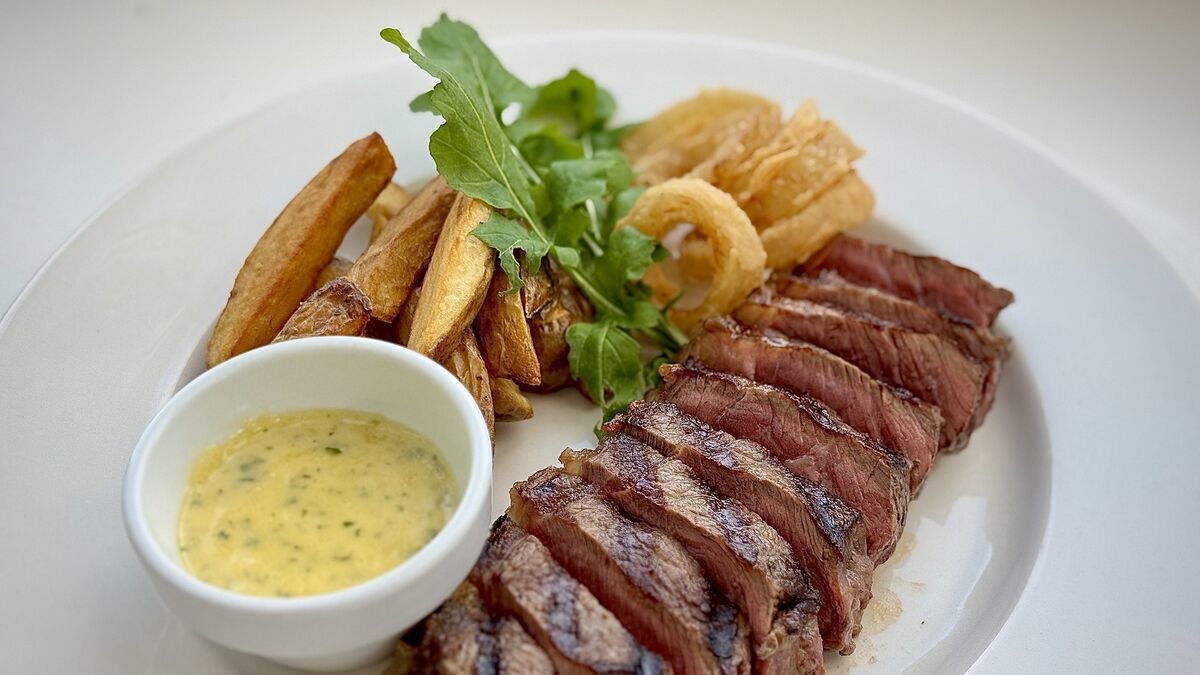
I love this combination, the sweetness of the peppers, salty anchovy and peppery rocket leaves, a perfect accompaniment to a juicy steak. Course Ingredients 6 x 175g sirloin or fillet steaks 1 garlic clove salt and freshly ground pepper a little olive oil 3 plump red peppers Anchoïade: Rocket leaves Method To prepare the steaks, about 1 hour before cooking cut a clove of garlic in half and rub it on both sides of each steak. This simple step intensifies the beefy flavour. Then grind some black pepper over the steaks and sprinkle on a few drops of olive oil. Turn the steaks in the oil and leave aside. If using sirloin steaks, score the fat at 2.5cm intervals. Next, roast the red peppers. Preheat the grill or better still use a charcoal grill or barbecue. Grill the peppers on all sides, turning them when necessary - they can be quite charred. Alternatively, preheat the oven to 250°C/Gas Mark 9. Put the peppers on a baking tray and bake for 20-30 minutes until the skin blisters and the flesh is soft. Put them into a bowl and cover for a few minutes, this will make them much easier to peel. Pull the skin off the peppers, remove the stalks and seeds. Do not wash or you will lose the precious sweet juices. Divide each into 2 or 3 pieces along the natural divisions. To cook the steaks. Heat the grill pan, season the steaks with a little salt and put them down onto the hot pan. Cook to your preference – rare, medium rare, medium or well done (see Pan-grilled Steak with Béarnaise Sauce for timings). Allow to rest. Transfer the steaks onto hot plates. Serve with roast red peppers, rocket leaves and a little blob of anchoïade. For the Anchoïade: Whizz all ingredients together except the oil in a food processor. Add the oil gradually. Taste and add a little more oil if necessary. (The anchovies act in the same way as egg yolks in mayonnaise and as a protein, will emulsify the oil). Be careful and keep a close eye as the oil starts to emulsify. If you feel it becomes too thick, add a little water. This will do two things; it will thin the anchoïade and will also stabilise the emulsion too which will stop it from splitting. When all the oil is incorporated and you have a lovely thick garlicky, anchovy emulsion, store in a covered jar in the fridge. Serve with crudités or just slathered on toast, bruschetta, or warm pitta bread.Pan-grilled Steak with Roasted Peppers & Anchoïade
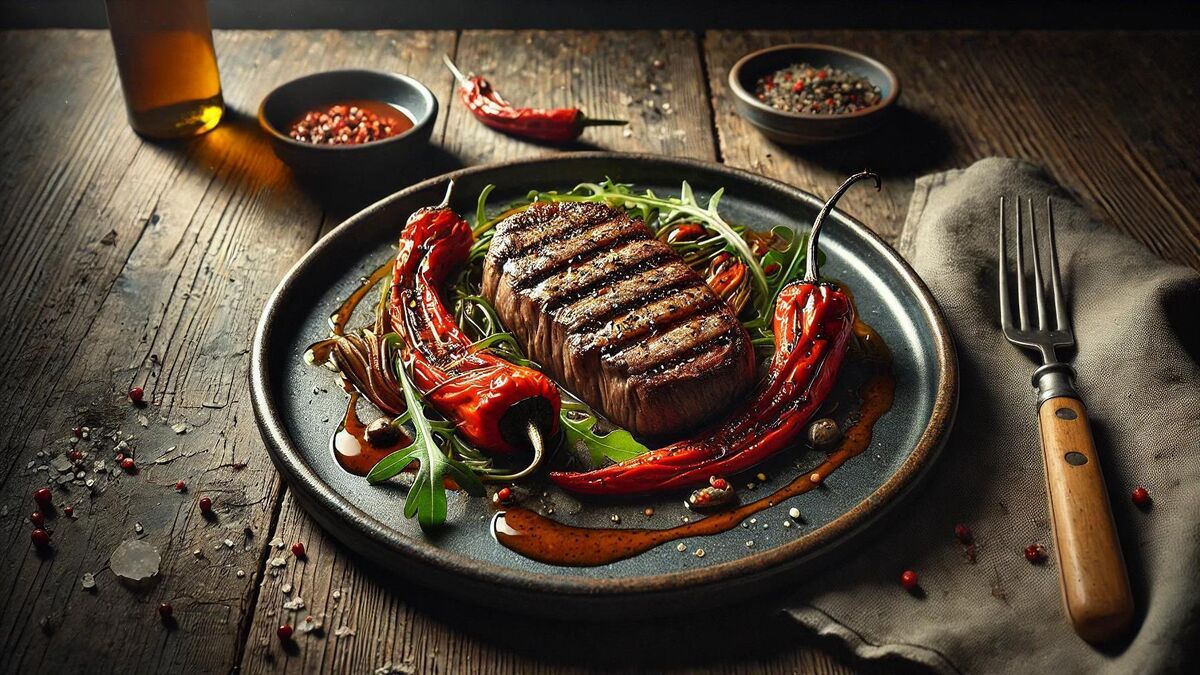
I so love that moment when I suddenly realise that winter is over. One can practically hear the tingle of excitement underneath the ground. Rhubarb and chives are pushing their way up through the soil, everything is stirring. We’ve already found some wild garlic to add to champ, salads and flavoured butters – so how about a bit of foraging in the open air this weekend?
There are two varieties allium ursinum or ramps, a broad-leaved bulbous plant which grows in moist woodland and allium triquetrum with a triangular steam also known as three-cornered leeks often grows along roadside verges. The la t ter has a flower that resembles ‘white’ bluebells, and pointy narrow leaves. They are often first to appear and are best for Champ. If you can find some of the pretty white flowers, scatter them over the top.
Waterford Festival of Food is one of Ireland’s largest and longest-running community food festivals. The main hub for this 3-day event is the scenic harbour town of Dungarvan, Co. Waterford on April 25-27 with events also taking place in nearby Lismore, Ardmore, Villierstown, Ballyduff, Cappoquin and Kilmeaden, making it a unique showcase of the flavours and characters local to this food region.
Highlights from this year’s programme include guided taste tours, kitchen table talks with influential people from Ireland’s food scene and beyond, high profile guest chef dining events, sustainability workshops, and pop-up experiences in unusual locations. There will also be foraging walks, food waste talks, bus tours to farms and mountains, live cooking demos, and the festival’s famous market, which is Ireland’s largest outdoor market, in Dungarvan’s market square on the final day.

